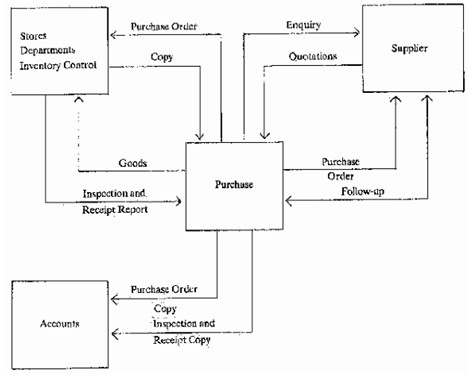By procedure we mean the entire set of steps in which a purchase transaction is carried through from its inception to its conclusion. These steps together form the purchase policy of an organization. Since there are wide variations among industries, companies, organizations, products and personnel, it would not be feasible to establish a single set of procedures which would apply to all cases. The following Purchase System and Procedure basic steps, however, must be taken in one way or another:
- Receipt and analysis of requisition to assess the need and description of requirement
- Selection of possible sources of supply
- Determining the time, price, quality and quantity
- Placing the order
- Following up and expediting of the order.
- Checking The invoice and receiving the order
- Processing discrepancies and rejections after inspection
- Communicating with accounts’ section for payment
- Closing completed records.
- Maintenance of records and files
A schematic purchase procedure involving some of these steps is shown in Figure V.

Purchase Forms
Forms are very important tools for purchasing department to standardize the communication with internal departments of the organization and external agencies such as supplier, local government bodies, etc. The number of forms required depends on the size of the organization, the purchasing system employed in the organization, and the accounting and internal control methods in effect. Normally there should not be too many forms as they create confusion and red tapeism. Certain links of communication can be sent copies of some forms (as shown in Figure V) Instead of individual forms the forms should incorporate the principles of good design to facilitate data. Entry and data retrieval, to minimize the Possibility of errors, and finally, to be just economically sufficient in size and number of entries required.
Purchase forms for the following functions are usually employed (some of which have already been exhibited).
- Purchase requisition
- Request for quotation
- Purchase order
- Follow-up
- Receiving and Inspection
In addition, some other forms are also used by some large organisations. Among such forms are: acknowledgement for quotation received, change of order notice, purchase contract, sample test report etc.
Purchase Records
Since purchasing is a repetitive process, accurate records are a necessity for efficient operation. These records provide a history of what has been done in the past (supplier, price, discounts, quality delivery etc.) and provide a wealth of information upon which to base future decisions. Maintaining a good-record system will increase operating costs but expectedly it should bring some handsome savings in the long run.
Most purchasing departments maintain the following basic records:
Purchase Order Log: It contains a numerical brief record of all purchase orders issued. It contains purchase order number, supplier’s name, brief description of purchase, total value of the order etc. The log makes it possible to summaries several administrative data.
Open Order File: Contains the status of all outstanding orders. It contains purchase requisition, purchase order, follow-up data.
Close Order File: Contains a historical data of all completed purchases.
Vendor Record: Contains the names and addresses of suppliers, materials that a supplier can supply, delivery and quality records.
Commodity Record: Such record is maintained on each major material or service that is purchased repetitively. It shows the list of suppliers, annual usage rate, price, orders placed, orders received and disbursements to the departments.
Contract File: Contains the purchase records of items under a term contract. It is specially important when the contract is an open one, against which orders may be placed.
Purchase Reports
Since the purchasing department handles a sizeable proportion of corporate finance, it is desirable to have some summary reports periodically (quarterly, half-yearly or annually) available to the management. Some of the important reports are:
- Total value of purchase.
- Allocation of purchase value against major items.
- Allocation of purchase value against each requisitioning department.
- Budget for purchase for the next year.
- Proposals for revisions of budget in current year.
In addition, the purchasing department brings out the report for its own use. They are:
- Vendor Performance Report
- Pattern of Consumption of materials.
- Pattern of market prices.

